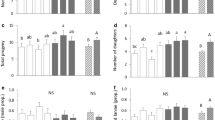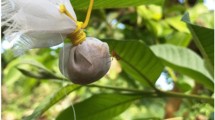Abstract
In zoophytophagous predators genetically determined efficiency to exploit either animal or plant resources could lead to diet specialization, and a trade-off between fitness performances on animal and plant diet. Such a trade-off would have important consequences on the efficiency of zoophytophagous species as biocontrol agents. We estimated the genetic basis for zoophagy and nymphal development length and the genetic correlation between these two traits, in the mullein bug, Campylomma verbasci (Meyer) (Hemiptera: Miridae). In the laboratory, we counted the number of spider mites and aphids killed in 24 h by C. verbasci from 12 isogroup lines, and the nymphal development length under a plant and a mixed diet. Among-line variance in the level of zoophagy on both prey was significant and positively correlated. Diet had no significant effect on the mean nymphal development length, but lines differed in nymphal development regardless of the diet. Our results reveal genetic differences in foraging efficiency on prey, which suggest that some genotypes in population of the zoophytophagous mullein bug could provide more benefits in apple orchards.




Similar content being viewed by others
References
Alomar O, Wiedenmann RN (eds) (1996) Zoophytophagous heteroptera: implications for life history and integrated pest management. Thomas Say Publications in Entomology, Entomological Society of America, Lanham
Arno J, Castané C, Riudavets J, Gabarra R (2010) Risk of damage to tomato crops by the generalist zoophytophagous predator Nesidiocoris tenuis (Reuter) (Hemiptera: Miridae). Bull Entomol Res 100:105–115
Arnoldi D, Stewart RK, Boivin G (1992) Predatory mirids of the green apple aphid Aphid pomi, the two-spotted spider mite Tetranychus urticae and the European red spider mite Panonychus ulmi in apple orchards in Québec. Entomophaga 37:283–292
Aubry O, Cormier D, Chouinard G, Lucas E (2015) Influence of plant, animal and mixed resources on development of the zoophytophagous plant bug Campylomma verbasci (Hemiptera: Miridae). Biocontrol Sci Technol 25:1426–1442
Bates D, Maechler M, Bolker B (2013) lme4: linear mixed-effects models using S4 classes. R package version 0.999999-2. http://CRAN.R-project.org/package=lme4
Boivin G, Stewart RK (1982) Identification and evaluations of damage to McIntosh apples by phytophagous mirids (Hemiptera: Miridae) in southwestern Québec. Can Entomol 114:1037–1045
Bolker BM, Brooks ME, Clark CJ, Geange SW, Poulsen JR, Stevens MHH, White JSS (2009) Generalized linear mixed models: a practical guide for ecology and evolution. Trends Ecol Evol 24:127–135
Bolnick DI, Svanback R, Fordyce JA, Yang LH, Davis JM, Hulsey CD, Forister ML (2003) The ecology of individuals: incidence and implications of individual specialization. Am Nat 161:1–28
Bolnick DI, Amarasekare P, Araujo MS, Burger R, Levine JM, Novak M, Rudolf VHW, Schreiber SJ, Urban MC, Vasseur DA (2011) Why intraspecific trait variation matters in community ecology. Trends Ecol Evol 26:183–192
Boyd DW Jr, Cohen AC, Alverson DR (2002) Digestive enzymes and stylet morphology of Deraeocoris nebulosus (Hemiptera: Miridae), a predacious plant bug. Ann Entomol Soc Am 95:395–401
Burnham KP, Anderson DR (2002) Model selection and multimodel inference: a practical information-theoretic approach. Springer Science and Business Media, Berlin
Calvo J, Bolckmans K, Stansly PA, Urbaneja A (2009) Predation by Nesidiocoris tenuis on Bemisia tabaci and injury to tomato. BioControl 54:237–246
Castané C, Arno J, Gabarra R, Alomar O (2011) Plant damage to vegetable crops by zoophytophagous mirid predators. Biol Control 59:22–29
Catoni C, Peters A, Schaefer HM (2008) Life history trade-offs are influenced by the diversity, availability and interactions of dietary antioxidants. Anim Behav 76:1107–1119
Cohen AC (1996) Plant feeding by predatory heteroptera: evolutionary and adaptational aspects of trophic switching. In: Alomar O, Wiedenmann RN (eds) Zoophytophagous heteroptera: implications for life-history and integrated pest management. Entomological society of America, Lanham, pp 1–17
Coll M (1996) Feeding and ovipositing on plants by an omnivorous insect predator. Oecologia 105:214–220
Coll M, Guershon M (2002) Omnivory in terrestrial arthropods: mixing plant and prey diets. Annu Rev Entomol 47:267–297
Coll M, Izraylevich S (1997) When predators also feed on plants: effects of competition and plant quality on omnivore-prey population dynamics. Ann Entomol Soc Am 90:155–161
Coll M, Ruberson JR (eds) (1998) Predatory Heteroptera: their ecology and use in biological control. Thomas Say Publications in Entomology, Entomological society of America, Lanham
David JR, Gibert P, Legout H, Petavy G, Capy P, Moreteau B (2005) Isofemale lines in Drosophila: an empirical approach to quantitative trait analysis in natural populations. Heredity 94:3–12
Dingemanse NJ, Dochtermann NA (2012) Quantifying individual variation in behaviour: mixed-effect modelling approaches. J Anim Ecol 82:39–54
Hoffmann AA, Parsons PA (1988) The analysis of quantitative variation in natural populations with isofemale strains. Génét Sélect et Évol 20:87–98
Hopper KR, Roush RT, Powell W (1993) Management of genetics of biological control introductions. Annu Rev Entomol 38:27–51
Hoy MA (1979) The potential for genetic improvement of predators for pest management programs. In: Genetics in relation to insect management. Rockefeller Foundation Press, New York, pp 106–115
Jaenike J (1985) Genetic and environmental determinants of food preference in Drosophila tripunctata. Evolution 39:362–369
Jaenike J, Holt RD (1991) Genetic variation for habitat preference: evidence and explanations. Am Nat 137:S67–S90
Kain DP, Agnello AM (2013) Relationship between plant phenology and Campylomma verbasci (Hemiptera: Miridae) damage to apple fruit. Environ Entomol 42:307–313
Legaspi JC, O’Neill RJ, Legaspi BC Jr (1996) Trade-offs in body weights, egg loads and fat reserves of field-collected Podisus maculiventris (Heteroptera: Pentatomidae). Physiol Chem Ecol 25:155–164
Lemos WP, Zanuncio JC, Ramalho FS, Zanuncio VV, Serrao JE (2010) Herbivory affects ovarian development in the zoophytophagous predator Brontocoris tabidus (Heteroptera: Pentatomidae). J Pest Sci 83:69–76
Lucas É, Alomar O (2001) Macrolophus caliginosus (Wagner) as an intraguild prey for the zoophytophagous Dicyphus tamaninii Wagner (Heteroptera: Miridae). Biol Control 20:147–152
Luna MG, Sánchez NE, Pereyra PC (2007) Parasitism of Tuta absoluta (Lepidoptera, Gelechiidae) by Pseudapanteles dignus (Hymenoptera, Braconidae) under laboratory conditions. Environ Entomol 36:887–893
Martin JGA, Pelletier F (2011) Measuring growth patterns in the field: effects of sampling regime and methods on standardized estimates. Can J Zool 89(6):529–537
Maupin JL, Riechert SE (2001) Superfluous killing in spiders: a consequence of adaptation to food-limited environments? Behav Ecol 12:569–576
McGregor RR, Gillespie DR, Quiring DMJ, Foisy MRJ (1999) Potential use of Dicyphus hesperus Knight (Heteroptera: Miridae) for biological control of pests of greenhouse tomatoes. Biol Control 16:104–110
McMullen RD, Jong C (1970) The biology and influence of pesticides on Campylomma verbasci (Heteroptera: Miridae). Can Entomol 102:1390–1394
Moreteau B, Capy P, Alonso-Moraga A, Munoz-Serrano A, Stockel J, David JR (1995) Genetic characterization of geographic populations using morphometrical traits in Drosophila melanogaster: isogroups versus isofemale lines. Genetica 96:207–215
Nachappa P, Margolies DC, Nechols JR, Morgan TJ (2010) Response of a complex foraging phenotypic to artificial selection on its component traits. Evol Ecol 24:631–655
Nachappa P, Margolies DC, Nechols JR, Campbell JF (2011) Variation in predator foraging behaviour changes predator-prey spatio-temporal dynamics. Funct Ecol 25:1309–1317
Nakagawa S, Schielzeth H (2010) Repeatability for Gaussian and non-Gaussian data: a practical guide for biologists. Biol Rev 85:935–956
Nannini M, Atzori F, Murgia G, Pisci R, Sanna F (2012) Use of predatory mirids for control of the tomato borer Tuta absoluta (Meyrick) in Sardinian greenhouse tomatoes. EPPO Bull 42:255–259
Naranjo SE, Gibson RL (1996) Phytophagy in predaceous Heteroptera: effects on life history and population dynamics. In: Alomar O, Wiedenmann RN (eds) Zoophytophagous Heteroptera: implications for life-history and integrated pest management. Entomological society of America, Lanham, pp 57–93
Perdikis DCH, Lykouressis DP (2004) Macrolophus pygmaeus (Hemiptera: Miridae) population parameters and biological characteristics when feeding on eggplant and tomato without prey. J Econ Entomol 97:1291–1298
Roff DA (2002) Life history evolution. Sinauer Associates, Sunderland
Roitberg BD, Gillespie DR, Quiring DMJ, Alma CR, Jenner WH, Perry J, Peterson JH, Salomon M, van Laerhoven S (2005) The cost of being an omnivore: mandible wear from plant feeding in a true bug. Naturwissenschaften 92:431–434
Roush RT (1979) Genetic improvement of parasites. In: Genetics in relation to insect management. Rockefeller Foundation Press, New York, pp 97–105
Sanchez JA (2008) Zoophytophagy in the plantbug Nesidiocoris tenuis. Agric For Entomol 10:75–80
Sih A, Cote J, Evans M, Fogarty S, Pruitt J (2012) Ecological implications of behavioural syndromes. Ecol Lett 15:278–289
Stearns SC (1989) Trade-offs in life-history evolution. Funct Ecol 3:259–268
Stephens PA, Sutherland WJ, Freckleton RP (1999) What is the Allee effect? Oikos 87:185–190
Svanbäck R, Bolnick DI (2005) Intraspecific competition affects the strength of individual specialization: an optimal diet theory method. Evol Ecol Res 7:993–1012
R Core Team (2013) R: a language and environment for statistical computing. R Foundation for statistical computing, Vienna. http://www.R-project.org/
Thistlewood HMA, Borden JH, McMullen RD (1990) Seasonal abundance of the mullein bug, Campylomma verbasci (Meyer) (Heteroptera: Miridae), on apple and mullein in the Okanagan Valley. Can Entomol 122:1045–1058
Torres JB, Barros EM, Coelho RR, Pimentel RMM (2010) Zoophytophagous pentatomids feeding on plants and implications for biological control. Arthropod Plant Interact 4:219–227
Urbaneja A, Tapia G, Stansly P (2005) Influence of host plant and prey availability on developmental time and survivorship of Nesidiocoris tenuis (Het.: Miridae). Biocontrol Sci Techn 15:513–518
Zappala L, Biondi A, Alma A, Al-Jboory IJ, Arno J, Bayram A, Desneux N (2013) Natural enemies of the South American moth, Tuta absoluta, in Europe, North Africa and Middle East, and their potential use in pest control strategies. J Pest Sci 86:635–647
Acknowledgments
We gratefully thank Olivier Aubry for his precious help during rearing setting and discussion on this work. We thank Pascale Ayotte, Andréanne Lavallée, Laurent Fraser, Sheena-Émilie Boucher and Maïlys Allirand for their help on the capture of individuals, maintenance of isogroup lines and tests. F.D. was supported by a Natural Sciences and Engineering Research Council of Canada (NSERC) fellowship. The project expenses were financed by NSERC discovery grants program allowed to E.L and D.R.
Author information
Authors and Affiliations
Corresponding author
Additional information
Handling Editor: Marta Montserrat.
Rights and permissions
About this article
Cite this article
Dumont, F., Lucas, E. & Réale, D. Evidence of genetic basis of zoophagy and nymphal developmental time in isogroup lines of the zoophytophagous mullein bug, Campylomma verbasci . BioControl 61, 425–435 (2016). https://doi.org/10.1007/s10526-016-9721-8
Received:
Accepted:
Published:
Issue Date:
DOI: https://doi.org/10.1007/s10526-016-9721-8




